Planning a trip with your pittie? Breed discrimination can make it difficult. But these tips for traveling with Pit Bulls will help!

Breed-specific legislation (BSL) has a big impact on pet travelers with bully breeds. But BSL affects more than just Pit Bulls. These laws, passed in jurisdictions across the country, target more than 100 breeds.
The breeds most often discriminated against are Pit Bulls, Rottweilers, Dobermans, German Shepherds, and Huskies — whether they’re purebred or mixed breeds. And the effects of these laws range from frustrating to devastating. So it’s important to know the rules and remedies before you go.
Traveling With Pit Bulls
I didn’t know much about breed specific discrimination until after I adopted two pitties. Cool Whip and Hercules are perfect examples of the stereotypical description of “pit bull-type dogs.” Especially Hercules with his big blocky head, thick neck, muscular build, and that set of cropped ears!
While both dogs get a lot of compliments when we’re out and about, they also get nervous looks. Believing the hype, people cross to the opposite side of the street. Parents pull their kids behind them. And some places have passed laws to keep them away.
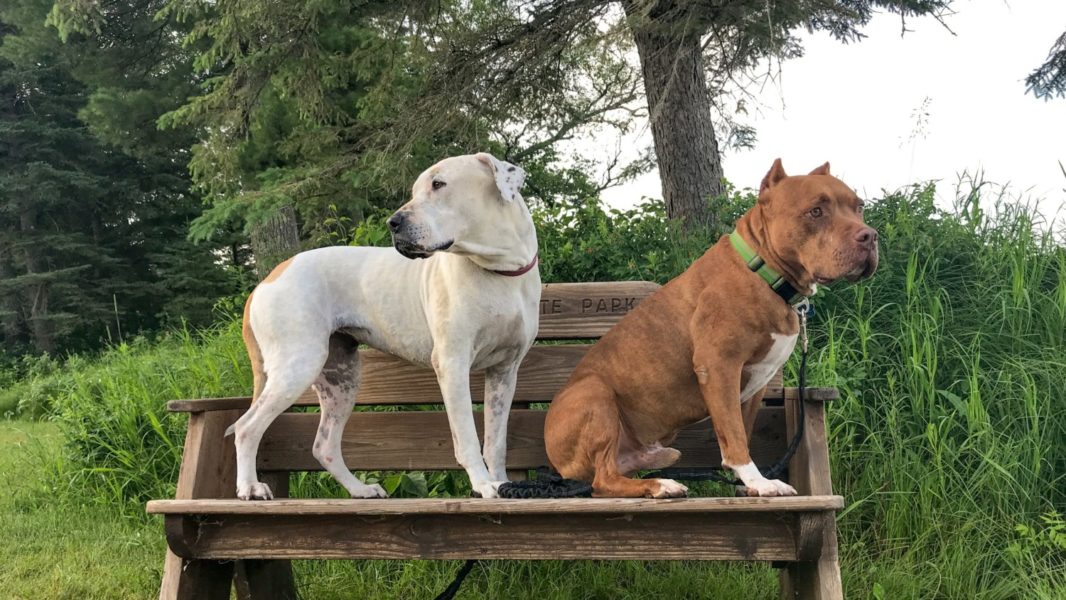
Breed Specific Legislation
Breed-specific legislation are laws banning or restricting certain dog breeds from a location or activity. And the punishment for breaking one of these laws ranges from a fine to confiscation and execution of the dog. For us, knowing which places to avoid is literally a matter of life and death.
But don’t be discouraged! Though traveling with Pit Bulls — or any targeted breed — can be intimidating, we make it work, and so can you! Herc, CW, and I have covered thousands of miles. We’ve visited almost every state west of the Mississippi River and four Canadian provinces. If you ignore my poor sense of direction, our travels have always gone well. It just takes a little extra preparation.
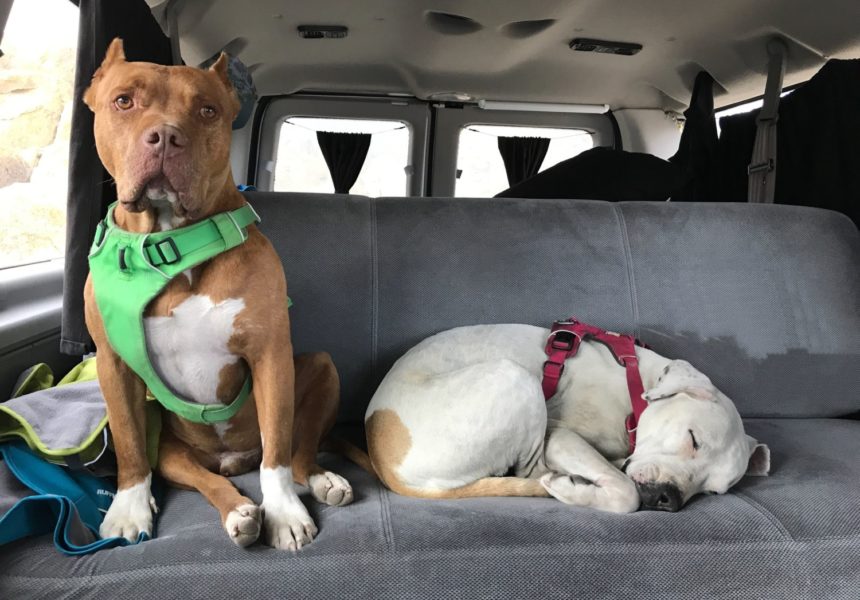
Use BSL Resources to Map Your Route
The first thing to do is get familiar with the resources that will help keep you safe. For travels in the U.S., I count on the interactive breed specific legislation map from the Animal Farm Foundation. For Canada, the entire Province of Ontario bans Pit Bulls, but beyond there the Justice for Bullies Bullies map is my go-to. Both of these websites clearly identify areas that have (or have had) BSL and give an overview of the specific rules for you to review.
To start planning a trip, grab your atlas and lay out your route. Then pull up the BSL websites and circle any places you need to avoid in red. From there you can adjust your itinerary, sticking to places where your dog is welcome.
Be sure to take your atlas on your trip, so you can easily refresh your memory on places that discriminate against your dog.
READ MORE ⇒ Traveling with Pets to Canada – Tips for Crossing the Border
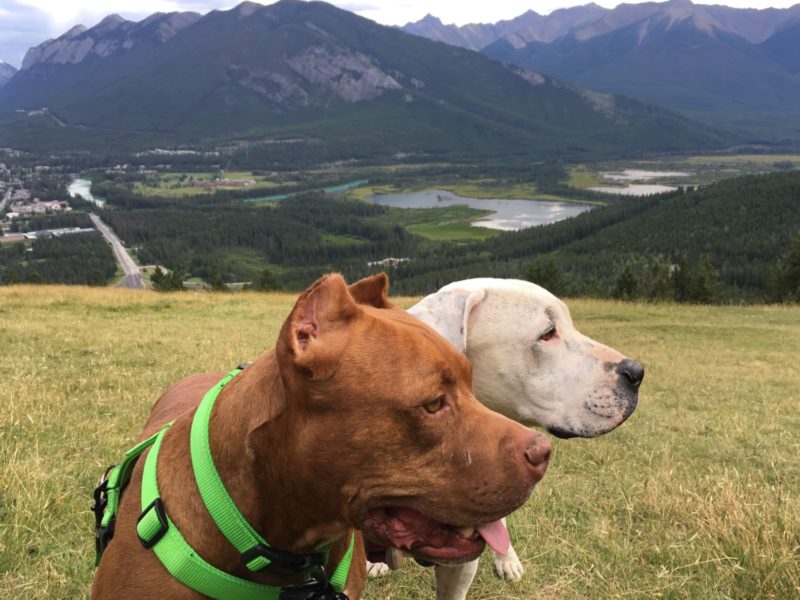
Protect Yourself and Your Dog from Breed Discrimination Laws
When deciding whether to travel through or stay in an area with BSL, make sure you understand the specifics of the local laws. Are your dogs allowed to stop in the area for potty breaks? Can you stay overnight with your dog? Does your dog have to be muzzled or meet any other requirements while out in public?
Here are some steps you can take to avoid any possible conflicts while traveling with a Pit Bull:
- If you will be traveling to or through a jurisdiction with a breed specific law, call the local animal control office to get the most current information about the restrictions and requirements.
- If your dog looks like one of the affected breeds, you might consider carrying DNA results from your vet proving your dog’s lineage.
- Remember that websites might not be completely current as the laws are changing constantly, so plan for the unexpected. If your dog is an affected breed, or could be mistaken for one, always be prepared to comply with muzzle, leash, and proof of insurance requirements.
- If you find that you have inadvertently violated a breed-specific law, be polite and do your best to bring yourself and your dog into compliance – even if that means immediately leaving the jurisdiction.
Once you know the rules, you can make plans to safely navigate through or around areas with BSL. Typically, I choose to bypass these places altogether. I’d rather spend my time and money in destinations that happily welcome my dogs.
READ MORE ⇒ Ruka the Pit Bull’s Road Trip from Alaska to Pennsylvania
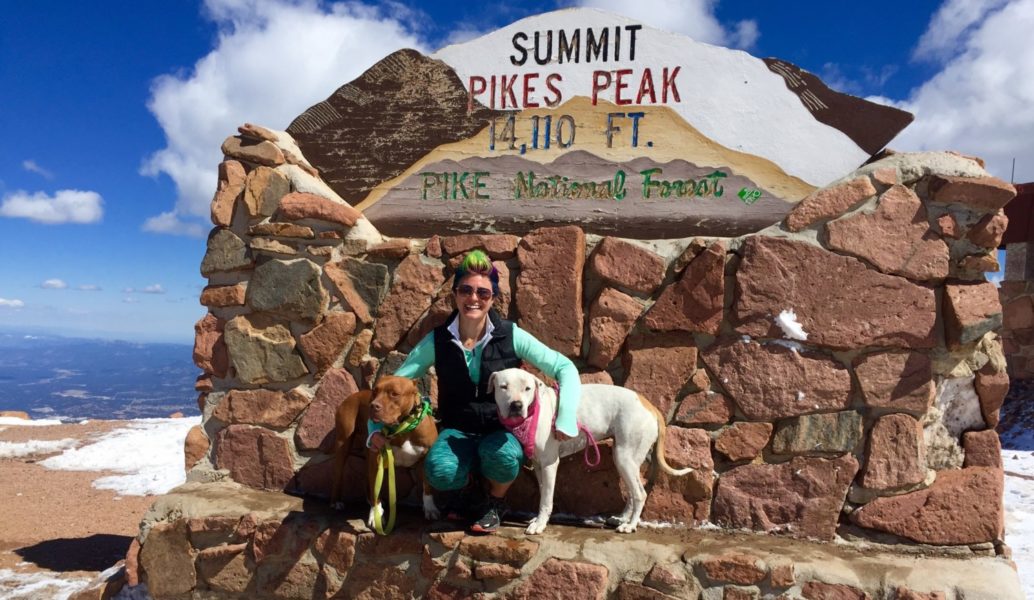
Call Ahead to Confirm Pet Polices
Keep in mind that discrimination doesn’t always stop at the state or city level. Some pet friendly businesses impose their own breed bans. For example, there are hotels, vacation rentals, and campgrounds that don’t allow certain dog breeds. Other lodgings take a less obvious approach, using weight limits to weed out larger dogs.
The same goes for boarding and daycare facilities. I was finalizing the details of a daycare reservation when I happened to ask if it mattered that my dogs were pitties. It turned out that the facility’s insurance did not cover Pit Bulls, so I had to find another option. It sometimes takes a little extra digging, but asking the most obvious questions can save you a lot of stress once you’re on the road.
At GoPetFriendly, we collect detailed pet polices for the businesses listed on our website, so you’ll know whether your dog is welcome. Just remember to call before leaving home to confirm that the pet policies haven’t changed.
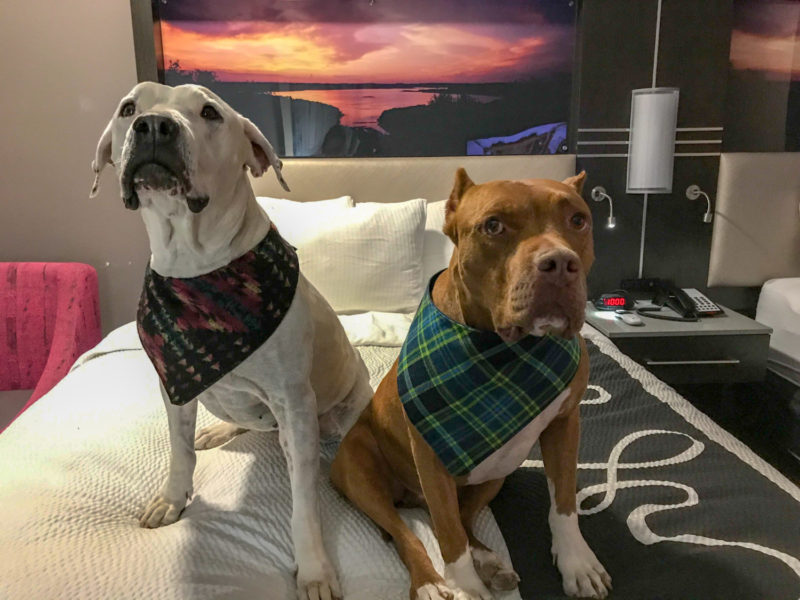
Places Without Breed Restrictions
If you’re looking for places to stay where your dog will always be welcome, watch for government-owned campgrounds. Whether it’s a national park, national forest, Army Corp of Engineers campground, or state park, you’ll never run into breed restrictions! The Kimpton hotel chain also welcomes pets of all breeds and sizes, and they never charge a pet fee.
READ MORE ⇒ State Parks With Pet Friendly Cabins, Campgrounds, Beaches And More
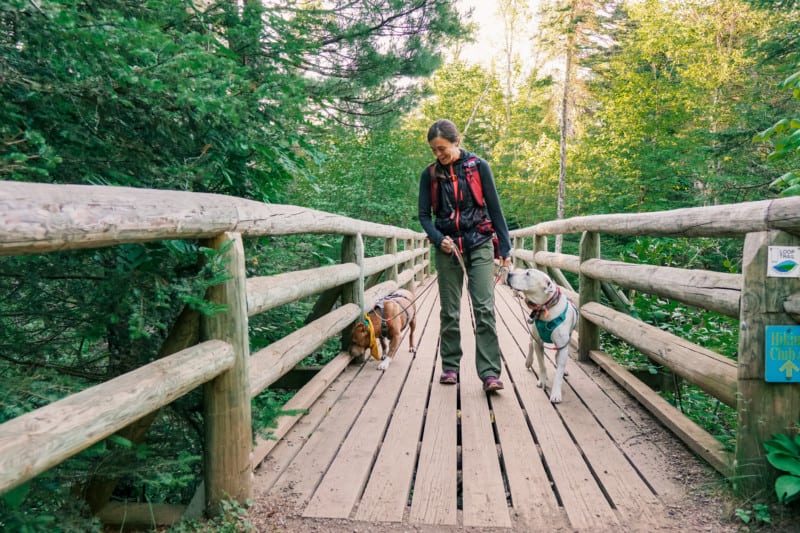
Be An Ambassador
I completely understand how frustrating and disheartening it is when your dog is not welcomed because of his breed or how she looks. Traveling with Pit Bulls requires additional research to ensure your dog is greeted kindly, but you CAN get out there and have fun together. And, when you do, you and your dog have the opportunity to be ambassadors for your breed. Show the world that all dogs deserve to be treated fairly!
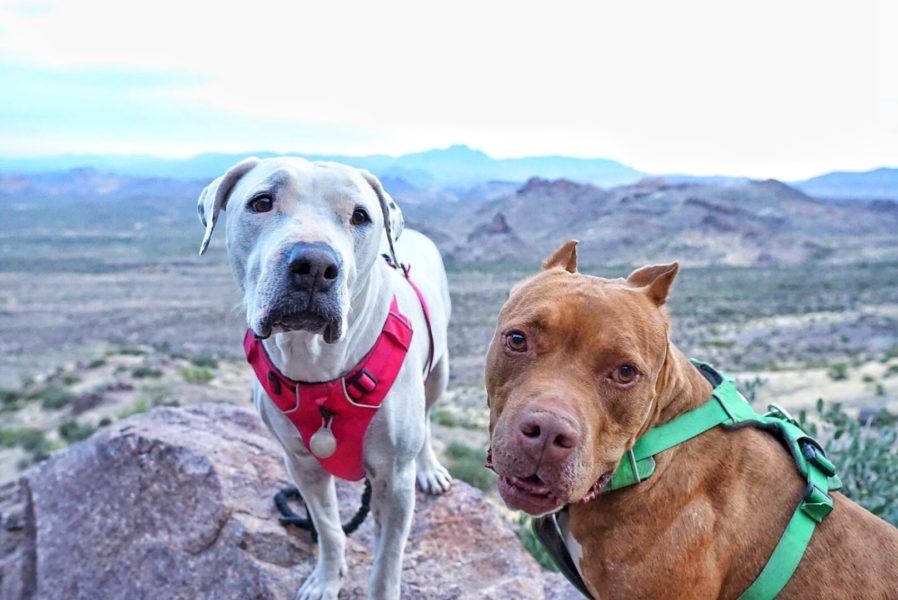
Cool Whip and Hercules love meeting people, and I’m happy to let people pet them and experience what Pit Bulls are really like. Aggressive bully breeds? Nah. The white one will promptly plant her bum on your feet hoping for scratches. And that squirrely brown fella with little ear nubs thinks he’s a 70-pound lap dog; he gets so excited to see people that he can’t stop licking things.
My hope is that by having a positive interaction with my dogs people will realize that every dog is an individual. They should be judged by their character and behavior, not with stereotypes and assumptions. In a way, breed discrimination inspires me to take my dogs traveling even more. If my dogs can break down even just one negative assumption, the extra effort is worth it!

We at GoPetFriendly strongly oppose Breed-Specific Laws.
Laws that discriminate against particular breeds of dogs are completely unacceptable. There is no evidence that breed specific laws are effective in preventing dog bites, but there is evidence that they have resulted in the senseless killing of thousands of homeless animals and beloved pets. We believe that “aggressive dog laws” that are not biased toward a specific breed are more enforceable and less prejudicial. We are particularly opposed any law resulting in the confiscation and execution of a dog that has done no harm.

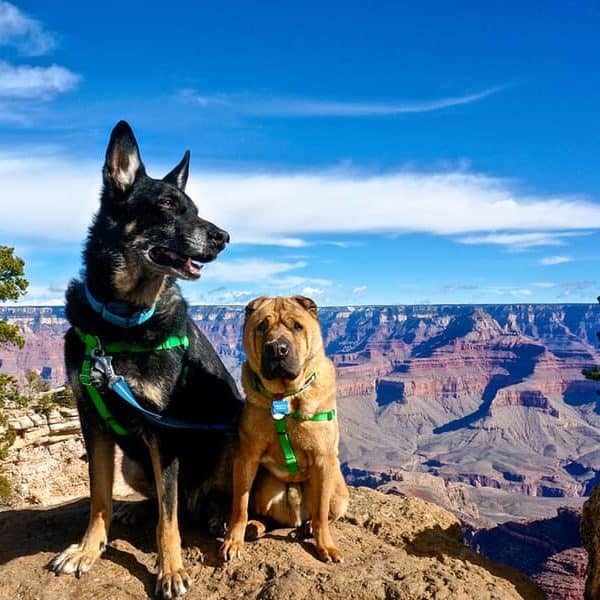

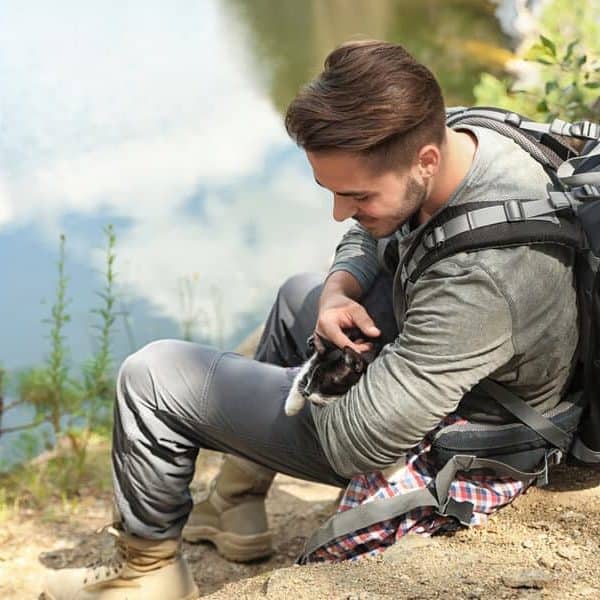

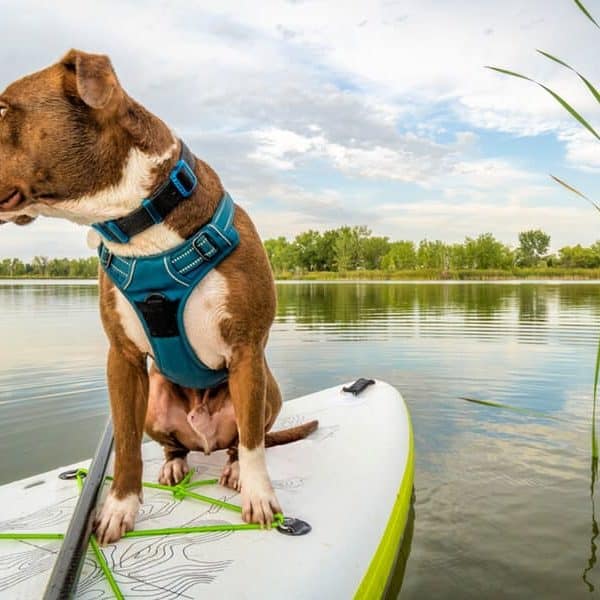



I own a pitbull and the only thing he ever attacked is his food bowl but I worry about taking him to Montana in a couple of months. Because people are afraid of the breed
This is the second pit I have owned and neither were aggressive but they can be very protective
Hi David, and thanks for your note! Yes, traveling with a pittie requires a bit more planning. But it’s also a wonderful experience when your pup is out there behaving beautifully and being an ambassador for his breed. I wish you safe and happy travels!